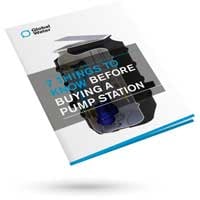Global Water provides packaged pump stations that are comprised of submersible pumps, polyethylene chamber, lifting chains, floats, a controller and hose kits. Once the pump stations arrive on site and begins to be installed it is not uncommon to run into issues. To help you avoid making these common mistakes we’ve identified them in this blog as well as some tips on how you can make sure these don’t happen to you.
Load bearing on the Poly chamber
The polyethylene chamber is not meant to be load bearing, but this commonly occurs when an improper excavation depth causes the cover to sit directly on the chamber or the chamber is not concrete encased for class D applications.
The polyethylene construction of the chamber allows for easy installation, but is not designed to be vehicle load bearing. If the cover rests directly on the chamber it will transfer the load from the surface to the poly, resulting in stresses on the chamber that it was not designed for.
Solution – Make sure you know the dimensions of your cover and your paving details to allow for proper excavation depth, and if it will be subject to vehicle traffic. Set your chamber down at least that far and ensure you tie your cast iron cover through to your paving detail. Alternatively encase your entire poly chamber in concrete. Installation instructions are available with the dimensional drawing of the pump station supplied at time of quote.
Insufficient cable
The special immersible cables that comes with our submersible pumps and floats are usually 10 metres long by default. Inaccurate measurements for the required distance of cables often holds up installation due to an electrician having to come on site and extend them, when the default length is insufficient.
Solution – Make sure you measure from where the pump will be sitting in the chamber and the length that it must run up the wall to connect to the controller. These are the measurements most often forgot about.
Absent or improper concrete ballast
If a pump station is not installed with a proper concrete ballast the bottom of the chamber might lift, or the pump station may push through the finished surface. This is often referred to as buoyancy and is caused by the upward pressure of the water table on the pump chamber.
Solution – Our Installation and Operation manuals (IOMs) include information regarding this, but in general the concrete should encase the base of the pump chamber and cover the first rib of the chamber. The chambers also have tie points for steel reinforcement at the bottom that anchor the chamber to the concrete ballast and counteract the buoyancy pressure.
Weights not attached to float cables
Not attaching weights to the float lines will often cause the float to not trigger since the the weight provides the pivot point in the float cable. This in turn causes the pump station to overflow.
Solution – Attach the weights to the float lines at the pivot point before you run them through the conduit. As a last resort, if you’ve already run the line you can use utility grade zip ties to attach the weights.
Miswiring the high-level alarm and stop float switch
After running all the cables through the conduit it can be easy to mix them up when you connect them to the controller. If your alarm is sounding when your pump first engages, this is a likely cause.
Solution – Double check the cables before connecting them, or even label the ends before pulling them through the conduit. Most controllers include wiring diagrams to show where the correct cables should go as well as providing directions in the IOM.
Uncleared hard debris impacting pumps
Rocks and other hard debris might get caught in the pump impeller causing pump damage or jamming. This is the most common malfunction in stormwater pump stations and can result in overflowing if the station is not maintained.
Solution - Clear out the bottom of the pump chamber if debris falls in during installation and flush the pipe work to make sure it is clear as well. Once operational, a regular checkup of the pump station to clear any debris and assess 'wear and tear' can help keep your pump station operating optimally.
Need assistance with your project? Contact Global Water to receive friendly and knowledgeable support.





